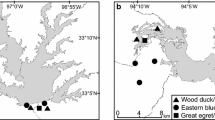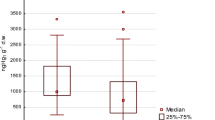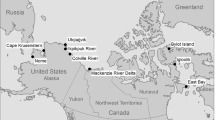Abstract
Penguins are reliable sentinels for environmental assessments of mercury (Hg) due to their longevity, abundance, high trophic level, and relatively small foraging areas. We analyzed Hg concentrations from blood and feathers of adult Humboldt penguins (Spheniscus humboldti) and feathers of chinstrap penguins (Pygoscelis antarcticus) from different reproductive colonies with variable degrees of urbanization and industrialization along the Chilean and Antarctic coasts. We evaluated Hg concentration differences between species, sexes (Humboldt penguins), and localities. Our results showed significantly greater levels in Humboldt penguins than in chinstrap penguins and nonsignificant differences between sexes among Humboldts. Penguin Hg concentrations showed a latitudinal pattern, with greater values of the metal at lower latitudes, independent of the species. Both studied penguin species showed elevated Hg concentrations compared to their congeners, highlighting the necessity to investigate potential negative effects on their populations. Although differences between species are possibly due to variation in diet and trophic level, our results suggest an important effect of the degree of Hg pollution adjacent to foraging areas. Further research on Hg content in prey species and environmental samples, together with a larger overall sample size, and investigation on penguin’s diet and trophic level are needed to elucidate Hg bioavailability in each location and the role of local Hg pollution levels. Likewise, it is important to monitor Hg and other heavy metals of ecotoxicological importance in penguin populations in vulnerable regions of Chile.




Similar content being viewed by others
References
Bargagli R, Monaci F, Sanchez-Hernandez JC, Cateni D (1998) Biomagnification of mercury in an Antarctic marine coastal food web. Mar Ecol Prog Ser 169:65–76
Bearhop S, Phillips R, Thompson D et al (2000) Variability in mercury concentrations of great skuas Catharacta skua: the influence of colony, diet and trophic status inferred from stable isotope signatures. Mar Ecol Prog Ser 195:261–268. https://doi.org/10.3354/meps195261
Becker PH, Gonzàlez-Solìs J, Behrends B, Croxall J (2002) Feather mercury levels in seabirds at South Georgia: influence of trophic position, sex and age. Mar Ecol Prog Ser 243:261–269. https://doi.org/10.3354/meps243261
Birdlife International (2016a) Spheniscus humboldti (amended version published in 2016). The IUCN red list of threatened species 2017: e.T22697817A111228184
Birdlife International (2016b) Pygoscelis antarcticus. The IUCN red list of threatened species 2016: e.T22697761A93638235
Blévin P, Carravieri A, Jaeger A et al (2013) Wide range of mercury contamination in chicks of southern ocean seabirds. PLoS ONE 8:e54508. https://doi.org/10.1371/journal.pone.0054508
Brasso RL, Polito MJ (2013) Trophic calculations reveal the mechanism of population-level variation in mercury concentrations between marine ecosystems: case studies of two polar seabirds. Mar Pollut Bull 75:244–249. https://doi.org/10.1016/j.marpolbul.2013.08.003
Brasso RL, Polito MJ, Lynch HJ et al (2012) Penguin eggshell membranes reflect homogeneity of mercury in the marine food web surrounding the Antarctic Peninsula. Sci Total Environ 439:165–171. https://doi.org/10.1016/j.scitotenv.2012.09.028
Brasso RL, Chiaradia A, Polito MJ et al (2015) A comprehensive assessment of mercury exposure in penguin populations throughout the Southern Hemisphere: using trophic calculations to identify sources of population-level variation. Mar Pollut Bull 97:408–418. https://doi.org/10.1016/j.marpolbul.2015.05.059
Burger J, Gochfeld M (1997) Risk, mercury levels, and birds: relating adverse laboratory effects to field biomonitoring. Environ Res 75:160–172. https://doi.org/10.1006/enrs.1997.3778
Calle P, Alvarado O, Monserrate L et al (2015) Mercury accumulation in sediments and seabird feathers from the Antarctic Peninsula. Mar Pollut Bull 91:410–417. https://doi.org/10.1016/j.marpolbul.2014.10.009
Cardiel IE, Taggart MA, Mateo R (2011) Using Pb–Al ratios to discriminate between internal and external deposition of Pb in feathers. Ecotoxicol Environ Saf 74:911–917. https://doi.org/10.1016/j.ecoenv.2010.12.015
Carravieri A, Bustamante P, Churlaud C, Cherel Y (2013) Penguins as bioindicators of mercury contamination in the Southern Ocean: birds from the Kerguelen Islands as a case study. Sci Total Environ 454–455:141–148. https://doi.org/10.1016/j.scitotenv.2013.02.060
Carravieri A, Bustamante P, Tartu S et al (2014) Wandering albatrosses document latitudinal variations in the transfer of persistent organic pollutants and mercury to southern ocean predators. Environ Sci Technol 48:14746–14755. https://doi.org/10.1021/es504601m
Carravieri A, Cherel Y, Jaeger A et al (2016) Penguins as bioindicators of mercury contamination in the southern Indian Ocean: geographical and temporal trends. Environ Pollut 213:195–205. https://doi.org/10.1016/j.envpol.2016.02.010
Carvalho PC, Bugoni L, McGill RAR, Bianchini A (2013) Metal and selenium concentrations in blood and feathers of petrels of the genus Procellaria. Environ Toxicol Chem. https://doi.org/10.1002/etc.2204
Castilla JC, Nealler E (1978) Marine environmental impact due to mining activities of El Salvador copper mine, Chile. Mar Pollut Bull 9:67–70. https://doi.org/10.1016/0025-326X(78)90451-4
Castro SH, Sánchez M (2003) Environmental viewpoint on small-scale copper, gold and silver mining in Chile. J Clean Prod 11:207–213. https://doi.org/10.1016/S0959-6526(02)00040-9
Celis JE, Espejo W, González-Acuña D et al (2014) Assessment of trace metals and porphyrins in excreta of Humboldt penguins (Spheniscus humboldti) in different locations of the northern coast of Chile. Environ Monit Assess 186:1815–1824. https://doi.org/10.1007/s10661-013-3495-6
Culik B (2001) Finding food in the open ocean: foraging strategies in Humboldt penguins. Zoology 104:327–338
Culik B, Luna-Jorquera G, Oyarzo H, Correa H (1998) Humboldt penguins monitored via VHF telemetry. Mar Ecol Prog Ser 162:279–286. https://doi.org/10.3354/meps162279
de Mendiburu F (2016) “Agricolae.” Statistical procedures for agricultural research. R Package
dos Santos IR, Silva-Filho EV, Schaefer C et al (2006) Baseline mercury and zinc concentrations in terrestrial and coastal organisms of Admiralty Bay, Antarctica. Environ Pollut 140:304–311. https://doi.org/10.1016/j.envpol.2005.07.007
Espejo W, Celis JE, González-Acuña D et al (2014) Concentration of trace metals in excrements of two species of penguins from different locations of the Antarctic Peninsula. Polar Biol 37:675–683. https://doi.org/10.1007/s00300-014-1468-z
Evers DC, Kaplan JD, Meyer MW et al (1998) Geographic trend in mercury measured in common loon feathers and blood. Environ Toxicol Chem 17:173. https://doi.org/10.1897/1551-5028(1998)017<0173:gtimmi>2.3.co;2
Finger A, Lavers JL, Dann P et al (2015) The Little Penguin (Eudyptula minor) as an indicator of coastal trace metal pollution. Environ Pollut 205:365–377. https://doi.org/10.1016/j.envpol.2015.06.022
Finger A, Lavers JL, Orbell JD et al (2016) Seasonal variation and annual trends of metals and metalloids in the blood of the Little Penguin (Eudyptula minor). Mar Pollut Bull 110:261–273. https://doi.org/10.1016/j.marpolbul.2016.06.055
Finger A, Lavers JL, Dann P et al (2017) Metals and metalloids in Little Penguin (Eudyptula minor) prey, blood and faeces. Environ Pollut 223:567–574. https://doi.org/10.1016/j.envpol.2017.01.059
Frias JE, Gil MN, Esteves JL et al (2012) Mercury levels in feathers of Magellanic penguins. Mar Pollut Bull 64:1265–1269. https://doi.org/10.1016/j.marpolbul.2012.02.024
Gaymer CF, Rojas U, Squeo FA et al (2008) AMCP-MU Isla Grande de Atacama: Flora y Fauna Marina y Terrestre. In: Squeo FA, Arancio G, Gutiérrez JR (eds) Libro Rojo de la Flora Nativa y de los Sitios Prioritarios para su Conservación: Región de Atacama. Ediciones Universidad de La Serena, La Serena, pp 223–249
Gochfeld M (2003) Cases of mercury exposure, bioavailability, and absorption. Ecotoxicol Environ Saf 56:174–179. https://doi.org/10.1016/S0147-6513(03)00060-5
Gochfeld M, Burger J (2001) Effects of chemicals and pollution on seabirds. In: Schreiber E, Burger J (eds) Biology of marine birds. CRC Press, Boca Raton, pp 485–526
Herling C, Culik BM, Hennicke JC (2005) Diet of the Humboldt penguin (Spheniscus humboldti) in northern and southern Chile. Mar Biol 147:13–25. https://doi.org/10.1007/s00227-004-1547-8
Higueras P, Oyarzun R, Oyarzún J et al (2004) Environmental assessment of copper–gold–mercury mining in the Andacollo and Punitaqui districts, northern Chile. Appl Geochemistry 19:1855–1864. https://doi.org/10.1016/j.apgeochem.2004.04.001
Honda K, Yamamoto Y, Hidaka H, Tatsukawa R (1986) Heavy metal accumulations in Adélie penguin, Pygoscelis adeliae, and their variations with the reproductive processes. Mem Nat Inst Polar Res (Special Issue) 40:443–453
Kokubun N, Lee WY, Kim J-H, Takahashi A (2015) Chinstrap penguin foraging area associated with a seamount in Bransfield Strait, Antarctica. Polar Sci 9:393–400. https://doi.org/10.1016/j.polar.2015.10.001
Lee MR, Correa JA (2005) Effects of copper mine tailings disposal on littoral meiofaunal assemblages in the Atacama region of northern Chile. Mar Environ Res 59:1–18. https://doi.org/10.1016/j.marenvres.2004.01.002
Leiva GMA, Morales S (2013) Environmental assessment of mercury pollution in urban tailings from gold mining. Ecotoxicol Environ Saf 90:167–173. https://doi.org/10.1016/j.ecoenv.2012.12.026
Lopez SA, Abarca N, Concha F, Meléndez R (2014) Heavy metal concentrations in two important fishes caught in artisanal fisheries of southeastern Pacific waters. Int J Agric Policy Res 2:414–420. https://doi.org/10.15739/IJAPR.014
Miranda DA (2015) Tasas de crecimiento en polluelos de Pingüinos de Humboldt: un estudio comparativo entre dos sitios reproductivos ubicados en el norte y sur de Chile. Universidad Católica del Norte, Antofagasta
Ochoa-Acuña H, Sepúlveda M, Gross T (2002) Mercury in feathers from Chilean birds: influence of location, feeding strategy, and taxonomic affiliation. Mar Pollut Bull 44:340–345. https://doi.org/10.1016/S0025-326X(01)00280-6
Pedro S, Xavier JC, Tavares S et al (2015) Mercury accumulation in gentoo penguins Pygoscelis papua: spatial, temporal and sexual intraspecific variations. Polar Biol 38:1335–1343. https://doi.org/10.1007/s00300-015-1697-9
Pohlert T (2014) The pairwise multiple comparison of mean ranks package (PMCMR). R Package 27
Polito MJ, Brasso RL, Trivelpiece WZ et al (2016) Differing foraging strategies influence mercury (Hg) exposure in an Antarctic penguin community. Environ Pollut 218:196–206. https://doi.org/10.1016/j.envpol.2016.04.097
Rey AR, Pütz K, Simeone A et al (2013) Comparative foraging behaviour of sympatric Humboldt and Magellanic penguins reveals species-specific and sex-specific strategies. Emu 113:145. https://doi.org/10.1071/MU12040
Robinson SA, Lajeunesse MJ, Forbes MR (2012) Sex differences in mercury contamination of birds: testing multiple hypotheses with meta-analysis. Environ Sci Technol 46:7094–7101. https://doi.org/10.1021/es204032m
Scheifler R, Gauthier-Clerc M, Le Bohec C et al (2005) Mercury concentrations in king penguin (Aptenodytes patagonicus) feathers at Crozet Islands (sub-Antarctic): temporal trend between 1966–1974 and 2000–2001. Environ Toxicol Chem 24:125. https://doi.org/10.1897/03-446.1
Simeone A, Araya B, Bernal M et al (2002) Oceanographic and climatic factors influencing breeding and colony attendance patterns of Humboldt penguins Spheniscus humboldti in central Chile. Mar Ecol Prog Ser 227:43–50. https://doi.org/10.3354/meps227043
Simeone A, Lara-Jorquera G, Bernal M et al (2003) Breeding distribution and abundance of seabirds on islands off north-central Chile. Rev Chil Hist Nat 76:323–333. https://doi.org/10.4067/S0716-078X2003000200016
Thiel M, Macaya E, Acuña E et al (2007) The Humboldt current system of northern and central Chile. In: Gibson R, Atkinson R, Gordon J (eds) Oceanography and marine biology. CRC Press, Boca Raton, pp 195–344
Thompson DR, Furness RW, Monteiro LR (1998) Seabirds as biomonitors of mercury inputs to epipelagic and mesopelagic marine food chains. Sci Total Environ 213:299–305. https://doi.org/10.1016/S0048-9697(98)00103-X
Universidad de Chile (2016) Informe País. Estado del Medio Ambiente en Chile. Comparación 1999–2015. Universidad de Chile, Instituto de Asuntos Públicos, Centro de Análisis de Políticas Públicas
US-EPA (1998) Method 7473 (SW-846): mercury in solids and solutions by thermal decomposition, amalgamation, and atomic absorption spectrophotometry
Vianna J, Cortez M, Ramos B et al (2014) Changes in abundance and distribution of Humboldt penguin Spheniscus humboldti. Mar Ornithol 42:153–159
Wilson RP, Wilson M-P, Duffy DC et al (1989) Diving behaviour and prey of the Humboldt penguin (Spheniscus humboldti). J Ornithol 130:75–79. https://doi.org/10.1007/BF01647164
Yamamoto Y, Kuramochi K, Nobuyuki T, Miyazaki YW, Naito Y (1996) Comparison of trace element concentrations in tissues of the chick and adult Adelie Penguins. Proc NIPR Symp Polar Biol 9:253–262
Zavalaga CB, Paredes R (1997) Sex determination of adult Humboldt penguins using morphometric characters. J Ornithol 68:102–112
Acknowledgements
Financial support for this study was provided by Fondecyt Nos. 11110060 and 1170972, INACH T 12_13, and CONICYT Master Scholarship. Laboratory analyses were performed at the Heavy Metals Laboratory (DECOL) of the Pontificia Universidad Católica de Chile and at the Heavy Metal Laboratory of the Universidad Andrés Bello. The authors thank Daniel González’s team for their contribution in sampling and Roberto Meléndez and Sebastian Klarian’s team for their help with laboratory work. Thanks to Nicole Sallaberry, Cayetano Espinosa, Bárbara Ramos, Fernanda Norambuena, Jose Luis Vega, Marcela Jauregui, and Betsy Pincheira for their support in fieldwork, lab analyses and English revision. Finally, the authors thank the journal’s reviewers for their comments and suggestions that helped us improve this manuscript.
Author information
Authors and Affiliations
Corresponding author
Ethics declarations
Conflict of interest
The authors declare that they have no conflict of interest.
Electronic supplementary material
Below is the link to the electronic supplementary material.
Rights and permissions
About this article
Cite this article
Álvarez-Varas, R., Morales-Moraga, D., González-Acuña, D. et al. Mercury Exposure in Humboldt (Spheniscus humboldti) and Chinstrap (Pygoscelis antarcticus) Penguins Throughout the Chilean Coast and Antarctica. Arch Environ Contam Toxicol 75, 75–86 (2018). https://doi.org/10.1007/s00244-018-0529-7
Received:
Accepted:
Published:
Issue Date:
DOI: https://doi.org/10.1007/s00244-018-0529-7




